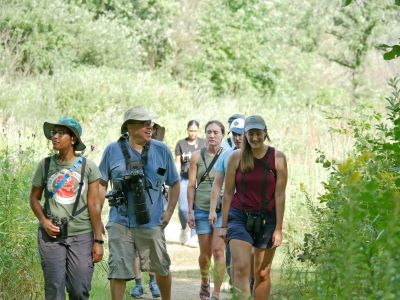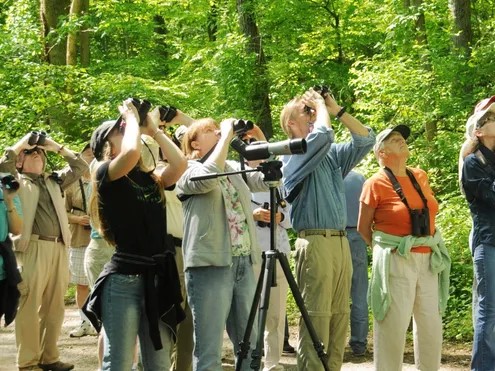Our First Saturday Bird Outings, created as part of our commitment to the Lane Audubon…
 By September, bird migration is in full swing. We can find shorebirds and ducks arriving at Fern Ridge and other waterways. We can see the Vaux’s Swifts at Agate Hall, as well as other chimneys around the area. A little farther from home, the raptor migration can be observed from atop Bonney Butte in the Mount Hood National Forest. I have never been to this location, but have heard it is a fun way to watch hawks fly over relatively closely and in high numbers. Hawk counters, banders, and an educator are on the butte every day from September 1to October 30, weather permitting. The site is open to the public and visitors are welcomed. The largest flight and peak migration typically occur between September 20 and October 10.
By September, bird migration is in full swing. We can find shorebirds and ducks arriving at Fern Ridge and other waterways. We can see the Vaux’s Swifts at Agate Hall, as well as other chimneys around the area. A little farther from home, the raptor migration can be observed from atop Bonney Butte in the Mount Hood National Forest. I have never been to this location, but have heard it is a fun way to watch hawks fly over relatively closely and in high numbers. Hawk counters, banders, and an educator are on the butte every day from September 1to October 30, weather permitting. The site is open to the public and visitors are welcomed. The largest flight and peak migration typically occur between September 20 and October 10.
Bonney Butte, just south of Oregon’s Mount Hood, is home to the largest known fall concentration of migrating raptors in Oregon. In 1994, HawkWatch International hired observers to conduct a season-long count, and in 1995 a small-scale banding program was begun. Each year, during the months of September and October, a total of 2,000 to 4,500 migrant hawks are seen from the top of Bonney Butte on the southeast side of Mt. Hood. The great majority of these birds are Sharp-shinned Hawks and Cooper’s Hawks. Migrating Merlins, Golden Eagles, Turkey Vultures, and Red-tailed Hawks are also commonly seen. A total of 18 migratory raptor species have been recorded to date. On a good day in late September, it’s possible to see 150 migrating hawks from the butte.
The concentration of hawks seen from the butte is a result of the local topography. Just north of Bonney Butte three large north-south ridges converge into a bottleneck that funnels birds over the butte as they travel south. The longest of these is Surveyor’s Ridge, which extends almost 30 miles south from the Columbia River all the way to Bonney Butte. The combined effect of this ridge with Bluegrass Ridge and Bennet Ridge is that under normal flight conditions, almost any hawk migrating across a wide area along the east side of Mt. Hood will be funneled over Bonney Butte. Hawks follow these north-south ridges as they migrate, because updrafts and thermals from the ridges provide the lift needed to travel long distances with minimal energy expenditure. After passing over the butte, the birds disperse again and travel over a much wider area. Banding data has shown that most of the hawks passing over Bonney Butte are migrating from breeding territories in southwest British Columbia to wintering grounds in Southern California.
This year a Bonney Butte Hawk Migration Festival will be held on September 22nd.
For directions and logistics check out these web links: hawkwatch.org/migration/item/81-bonney-butte-hawkwatch and hawkwatch.org/images/stories/Conservation_Science/Site_Brochures/Bonney_butte_brochure_2014.pdf



